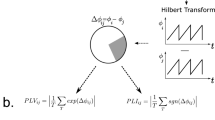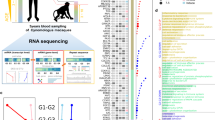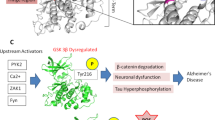Abstract
Aging is characterized with a progressive decline in many cognitive functions, including behavioral flexibility, an important ability to respond appropriately to changing environmental contingencies. However, the underlying mechanisms of impaired behavioral flexibility in aging are not clear. In this study, we reported that necroptosis-induced reduction of neuronal activity in the basolateral amygdala (BLA) plays an important role in behavioral inflexibility in 5-month-old mice of the senescence-accelerated mice prone-8 (SAMP8) line, a well-established model with age-related phenotypes. Application of Nec-1s, a specific inhibitor of necroptosis, reversed the impairment of behavioral flexibility in SAMP8 mice. We further observed that the loss of glycogen synthase kinase 3α (GSK-3α) was strongly correlated with necroptosis in the BLA of aged mice and the amygdala of aged cynomolgus monkeys (Macaca fascicularis). Moreover, genetic deletion or knockdown of GSK-3α led to the activation of necroptosis and impaired behavioral flexibility in wild-type mice, while the restoration of GSK-3α expression in the BLA arrested necroptosis and behavioral inflexibility in aged mice. We further observed that GSK-3α loss resulted in the activation of mTORC1 signaling to promote RIPK3-dependent necroptosis. Importantly, we discovered that social isolation, a prevalent phenomenon in aged people, facilitated necroptosis and behavioral inflexibility in 4-month-old SAMP8 mice. Overall, our study not only revealed the molecular mechanisms of the dysfunction of behavioral flexibility in aged people but also identified a critical lifestyle risk factor and a possible intervention strategy.
This is a preview of subscription content, access via your institution
Access options
Subscribe to this journal
Receive 12 print issues and online access
$259.00 per year
only $21.58 per issue
Buy this article
- Purchase on SpringerLink
- Instant access to full article PDF
Prices may be subject to local taxes which are calculated during checkout





Similar content being viewed by others
References
Breton YA, Seeland KD, Redish AD. Aging impairs deliberation and behavioral flexibility in inter-temporal choice. Front Aging Neurosci. 2015;7:41.
Diamond A, Lee K. Interventions shown to aid executive function development in children 4 to 12 years old. Science. 2011;333:959–64.
Burt KB, Paysnick AA. Resilience in the transition to adulthood. Dev Psychopathol. 2012;24:493–505.
Burke SN, Mormino EC, Rogalski EJ, Kawas CH, Willis RJ, Park DC. What are the later life contributions to reserve, resilience, and compensation? Neurobiol Aging. 2019;83:140–4.
Uddin LQ. Cognitive and behavioural flexibility: neural mechanisms and clinical considerations. Nat Rev Neurosci. 2021;22:167–79.
Calu DJ, Roesch MR, Stalnaker TA, Schoenbaum G. Associative encoding in posterior piriform cortex during odor discrimination and reversal learning. Cereb Cortex. 2007;17:1342–9.
Majak K, Ronkko S, Kemppainen S, Pitkanen A. Projections from the amygdaloid complex to the piriform cortex: A PHA-L study in the rat. J Comp Neurol. 2004;476:414–28.
Izquierdo A, Murray EA. Combined unilateral lesions of the amygdala and orbital prefrontal cortex impair affective processing in rhesus monkeys. J Neurophysiol. 2004;91:2023–39.
Coutureau E, Marchand AR, Di Scala G. Goal-directed responding is sensitive to lesions to the prelimbic cortex or basolateral nucleus of the amygdala but not to their disconnection. Behav Neurosci. 2009;123:443–8.
Burgos-Robles A, Kimchi EY, Izadmehr EM, Porzenheim MJ, Ramos-Guasp WA, Nieh EH, et al. Amygdala inputs to prefrontal cortex guide behavior amid conflicting cues of reward and punishment. Nat Neurosci. 2017;20:824.
Zeeb FD, Floresco SB, Winstanley CA. Contributions of the orbitofrontal cortex to impulsive choice: interactions with basal levels of impulsivity, dopamine signalling, and reward-related cues. Psychopharmacology. 2010;211:87–98.
Roesch MR, Esber GR, Bryden DW, Cerri DH, Haney ZR, Schoenbaum G. Normal aging alters learning and attention-related teaching signals in basolateral amygdala. J Neurosci. 2012;32:13137–44.
Mobini S, Body S, Ho MY, Bradshaw CM, Szabadi E, Deakin JF, et al. Effects of lesions of the orbitofrontal cortex on sensitivity to delayed and probabilistic reinforcement. Psychopharmacol (Berl). 2002;160:290–8.
Winstanley CA, Eagle DM, Robbins TW. Behavioral models of impulsivity in relation to ADHD: Translation between clinical and preclinical studies. Clin Psychol Rev. 2006;26:379–95.
Tait DS, Chase EA, Brown VJ. Tacrine improves reversal learning in older rats. Neuropharmacology. 2013;73:284–9.
Uprety A, Moss MB, Rosene DL, Killiany RJ, Moore TL, Curcumin improves reversal learning in middle-aged rhesus monkeys. Behav Neurosci. 2022;136:126–38.
Schoenbaum G, Nugent S, Saddoris MP, Gallagher M. Teaching old rats new tricks: Age-related impairments in olfactory reversal learning. Neurobiol Aging. 2002;23:555–64.
Eppinger B, Schuck NW, Nystrom LE, Cohen JD. Reduced striatal responses to reward prediction errors in older compared with younger adults. J Neurosci. 2013;33:9905–12.
Simon NW, LaSarge CL, Montgomery KS, Williams MT, Mendez IA, Setlow B, et al. Good things come to those who wait: Attenuated discounting of delayed rewards in aged Fischer 344 rats. Neurobiol Aging. 2010;31:853–62.
Morrison JH, Hof PR. Life and death of neurons in the aging brain. Science. 1997;278:412–9.
Haug H, Kuhl S, Mecke E, Sass NL, Wasner K. The significance of morphometric procedures in the investigation of age changes in cytoarchitectonic structures of human brain. J Hirnforsch. 1984;25:353–74.
West MJ. Regionally specific loss of neurons in the aging human hippocampus. Neurobiol Aging. 1993;14:287–93.
Kordower JH, Chu Y, Stebbins GT, DeKosky ST, Cochran EJ, Bennett D, et al. Loss and atrophy of layer II entorhinal cortex neurons in elderly people with mild cognitive impairment. Ann Neurol. 2001;49:202–13.
Li GM, Cheng HY, Zhang XZ, Shang XM, Xie H, Zhang X, et al. Hippocampal neuron loss is correlated with cognitive deficits in SAMP8 mice. Neurol Sci. 2013;34:963–9.
Niikura T, Tajima H, Kita Y. Neuronal cell death in Alzheimer’s disease and a neuroprotective factor, humanin. Curr Neuropharmacol. 2006;4:139–47.
Aisen PS, Petersen RC, Donohue M, Weiner MW, Alzheimer’s Disease Neuroimaging I. Alzheimer’s disease neuroimaging initiative 2 clinical core: progress and plans. Alzheimers Dement. 2015;11:734–9.
Lalaoui N, Lindqvist LM, Sandow JJ, Ekert PG. The molecular relationships between apoptosis, autophagy and necroptosis. Semin Cell Dev Biol. 2015;39:63–69.
Arguelles S, Guerrero-Castilla A, Cano M, Munoz MF, Ayala A. Advantages and disadvantages of apoptosis in the aging process. Ann NY Acad Sci. 2019;1443:20–33.
Deepa SS, Unnikrishnan A, Matyi S, Hadad N, Richardson A, Necroptosis increases with age and is reduced by dietary restriction. Aging Cell. 2018;17:e12770.
Murakami Y, Matsumoto H, Roh M, Giani A, Kataoka K, Morizane Y, et al. Programmed necrosis, not apoptosis, is a key mediator of cell loss and DAMP-mediated inflammation in dsRNA-induced retinal degeneration. Cell Death Differ. 2014;21:270–7.
Meng LJ, Jin W, Wang XD. RIP3-mediated necrotic cell death accelerates systematic inflammation and mortality. P Natl Acad Sci USA. 2015;112:11007–12.
Caccamo A, Branca C, Piras IS, Ferreira E, Huentelman MJ, Liang WS, et al. Necroptosis activation in Alzheimer’s disease. Nat Neurosci. 2017;20:1236.
Re DB, Le Verche V, Yu CH, Amoroso MW, Politi KA, Phani S, et al. Necroptosis drives motor neuron death in models of both sporadic and familial ALS. Neuron. 2014;81:1001–8.
Iannielli A, Bido S, Folladori L, Segnali A, Cancellieri C, Maresca A, et al. Pharmacological inhibition of necroptosis protects from dopaminergic neuronal cell death in Parkinson's disease models. Cell Rep. 2018;22:2066–79.
Amson R, Lassalle JM, Halley H, Prieur S, Lethrosne F, Roperch JP, et al. Behavioral alterations associated with apoptosis and down-regulation of presenilin 1 in the brains of p53-deficient mice. Proc Natl Acad Sci USA. 2000;97:5346–50.
Yanai S, Endo S. Early onset of behavioral alterations in senescence-accelerated mouse prone 8 (SAMP8). Behav Brain Res. 2016;308:187–95.
Rudebeck PH, Walton ME, Smyth AN, Bannerman DM, Rushworth MF. Separate neural pathways process different decision costs. Nat Neurosci. 2006;9:1161–8.
Abela AR, Duan YR, Chudasama Y. Hippocampal interplay with the nucleus accumbens iscritical for decisions about time. Eur J Neurosci. 2015;42:2224–33.
Hernandez CM, Orsini CA, Labiste CC, Wheeler AR, Ten Eyck TW, Bruner MM, et al. Optogenetic dissection of basolateral amygdala contributions to intertemporal choice in young and aged rats. Elife 2019;8:e46174.
Cohen P, Frame S. The renaissance of GSK3. Nat Rev Mol Cell Biol. 2001;2:769–76.
Zhou J, Freeman TA, Ahmad F, Shang X, Mangano E, Gao E, et al. GSK-3alpha is a central regulator of age-related pathologies in mice. J Clin Invest. 2013;123:1821–32.
Zhou JB, Freeman TA, Ahmad F, Shang XY, Mangano E, Gao EH, et al. GSK-3 alpha is a central regulator of age-related pathologies in mice. J Clin Invest. 2013;123:1821–32.
Ahmad F, Lal H, Zhou JB, Vagnozzi RJ, Yu JE, Shang XY, et al. Cardiomyocyte-specific deletion of Gsk3 alpha mitigates post-myocardial infarction remodeling, contractile dysfunction, and heart failure. J Am Coll Cardiol. 2014;64:696–706.
Xie YD, Zhao YF, Shi L, Li W, Chen K, Li M, et al. Gut epithelial TSC1/mTOR controls RIPK3-dependent necroptosis in intestinal inflammation and cancer. J Clin Invest. 2020;130:2111–28.
Blagosklonny MV. Rapamycin for longevity: opinion article. Aging. 2019;11:8048–67.
Hansen T, Slagsvold B. Late-life loneliness in 11 European countries: results from the generations and gender survey. Soc Indic Res. 2016;129:445–64.
Rico-Uribe LA, Caballero FF, Olaya B, Tobiasz-Adamczyk B, Koskinen S, Leonardi M, et al. Loneliness, social networks, and health: a cross-sectional study in three countries. PLoS One 2016;11:e0145264.
Chen YRR, Schulz PJ, The effect of information communication technology interventions on reducing social isolation in the elderly: a systematic review. J Med Internet Res. 2016;18:e18.
Cacioppo JT, Hawkey LC. Perceived social isolation and cognition. Trends Cogn Sci. 2009;13:447–54.
Masi CM, Chen HY, Hawkley LC, Cacioppo JT. A meta-analysis of interventions to reduce loneliness. Pers Soc Psychol Rev. 2011;15:219–66.
Shao LF, Yu SP, Ji W, Li HZ, Gao YL. The contribution of necroptosis in neurodegenerative diseases. Neurochem Res. 2017;42:2117–26.
Royce GH, Brown-Borg HM, Deepa SS. The potential role of necroptosis in inflammaging and aging. Geroscience. 2019;41:795–811.
Yang SH, Lee DK, Shin J, Lee S, Baek S, Kim J, et al. Nec-1 alleviates cognitive impairment with reduction of A and tau abnormalities in APP/PS1 mice. Embo Mol Med. 2017;9:61–77.
Zhang S, Wang Y, Li D, Wu J, Si W, Wu Y, Necrostatin-1 attenuates inflammatory response and improves cognitive function in chronic ischemic stroke mice. Medicines 2016; 3.
Jinawong K, Apaijai N, Wongsuchai S, Pratchayasakul W, Chattipakorn N, Chattipakorn SC. Necrostatin-1 Mitigates Cognitive Dysfunction in Prediabetic Rats With No Alteration in Insulin Sensitivity. Diabetes. 2020;69:1411–23.
Duan SC, Wang XQ, Chen G, Quan CX, Qu SQ, Tong JB, Inhibiting RIPK1 limits neuroinflammation and alleviates postoperative cognitive impairments in d-galactose-induced aged mice. Front Behav Neurosci. 2018;12:138.
Benito E, Urbanke H, Ramachandran B, Barth J, Halder R, Awasthi A, et al. HDAC inhibitor-dependent transcriptome and memory reinstatement in cognitive decline models. J Clin Invest. 2015;125:3572–84.
Wang D, Zhao M, Chen GZ, Cheng X, Han XX, Lin S, et al. The histone deacetylase inhibitor vorinostat prevents TNF alpha-induced necroptosis by regulating multiple signaling pathways. Apoptosis. 2013;18:1348–62.
Maurin H, Lechat B, Dewachter I, Ris L, Louis JV, Borghgraef P, et al. Neurological characterization of mice deficient in GSK3 alpha highlight pleiotropic physiological functions in cognition and pathological activity as Tau kinase. Mol Brain. 2013; 6.
Kaidanovich-Beilin O, Lipina TV, Takao K, van Eede M, Hattori S, Laliberte C, et al. Abnormalities in brain structure and behavior in GSK-3alpha mutant mice. Mol Brain. 2009; 2.
Russell JC, Kishimoto K, O’Driscoll C, Hossain MA. Neuronal pentraxin 1 induction in hypoxic-ischemic neuronal death is regulated via a glycogen synthase kinase-3 alpha/beta dependent mechanism. Cell Signal. 2011;23:673–82.
Nonaka S, Chuang DM. Neuroprotective effects of chronic lithium on focal cerebral ischemia in rats. Neuroreport. 1998;9:2081–4.
Nonaka S, Hough CJ, Chuang DM. Chronic lithium treatment robustly protects neurons in the central nervous system against excitotoxicity by inhibiting N-methyl-D-aspartate receptor-mediated calcium influx. Proc Natl Acad Sci USA. 1998;95:2642–7.
Grassilli E, Ianzano L, Bonomo S, Missaglia C, Cerrito MG, Giovannoni R, et al. GSK3A is redundant with GSK3B in modulating drug resistance and chemotherapy-induced necroptosis. PLoS One. 2014;9:e100947.
Kim YC, Guan KL. mTOR: a pharmacologic target for autophagy regulation. J Clin Invest. 2015;125:25–32.
Ha S, Ryu HY, Chung KM, Baek SH, Kim EK, Yu SW, Regulation of autophagic cell death by glycogen synthase kinase-3 beta in adult hippocampal neural stem cells following insulin withdrawal. Mol Brain. 2015; 8:30.
Yang Y, Jia YM, Sun QW, Dong HB, Zhao RQ. White light emitting diode induces autophagy in hippocampal neuron cells through GSK-3-mediated GR and ROR alpha pathways. Aging-Us. 2019;11:1832–49.
Van Skike CE, Lin AL, Burbank RR, Halloran JJ, Hernandez SF, Cuvillier J, et al. mTOR drives cerebrovascular, synaptic, and cognitive dysfunction in normative aging. Aging Cell 2020;19:e13057.
Manning BD, Tee AR, Logsdon MN, Blenis J, Cantley LC. Identification of the tuberous sclerosis complex-2 tumor suppressor gene product tuberin as a target of the phosphoinositide 3-Kinase/Akt pathway. Mol Cell. 2002;10:151–62.
Courtin E, Knapp M. Social isolation, loneliness and health in old age: a scoping review. Health Soc Care Comm. 2017;25:799–812.
Gorenko JA, Moran C, Flynn M, Dobson K, Konnert C. Social isolation and psychological distress among older adults related to COVID-19: a narrative review of remotely-delivered interventions and recommendations. J Appl Gerontol. 2021;40:3–13.
Fratiglioni L, Paillard-Borg S, Winblad B. An active and socially integrated lifestyle in late life might protect against dementia. Lancet Neurol. 2004;3:343–53.
Wilson RS, Krueger KR, Arnold SE, Schneider JA, Kelly JF, Barnes LL, et al. Loneliness and risk of Alzheimer disease. Arch Gen Psychiat. 2007;64:234–40.
Cacioppo JT, Hawkley LC, Ernst JM, Burleson M, Berntson GG, Nouriani B, et al. Loneliness within a nomological net: An evolutionary perspective. J Res Pers. 2006;40:1054–85.
Umberson D, Montez JK. Social relationships and health: a flashpoint for health policy. J Health Soc Behav. 2010;51:S54–66.
Read S, Comas-Herrera A, Grundy E. Social isolation and memory decline in later-life. J Gerontol B Psychol Sci Soc Sci. 2020;75:367–76.
Amitai N, Young JW, Higa K, Sharp RF, Geyer MA, Powell SB. Isolation rearing effects on probabilistic learning and cognitive flexibility in rats. Cogn Affect Behav Ne. 2014;14:388–406.
Li N, Wu X, Li L. Chronic administration of clozapine alleviates reversal-learning impairment in isolation-reared rats. Behav Pharm. 2007;18:135–45.
Lee SH, Kim YB, Which type of social activities may reduce cognitive decline in the elderly?: A longitudinal population-based study. BMC Geriatr. 2016;16:165.
Weil ZM, Norman GJ, Barker JM, Su AJ, Nelson RJ, DeVries AC. Social isolation potentiates cell death and inflammatory responses after global ischemia. Mol Psychiatr. 2008;13:913–5.
Doulames VM, Vilcans M, Lee S, Shea TB, Social interaction attenuates the extent of secondary neuronal damage following closed head injury in mice. Front Behav Neurosci. 2015;9:275.
Ahmad F, Lal H, Zhou J, Vagnozzi RJ, Yu JE, Shang X, et al. Cardiomyocyte-specific deletion of Gsk3alpha mitigates post-myocardial infarction remodeling, contractile dysfunction, and heart failure. J Am Coll Cardiol. 2014;64:696–706.
Kim J, Ragozzino ME. The involvement of the orbitofrontal cortex in learning under changing task contingencies. Neurobiol Learn Mem. 2005;83:125–33.
Zhang Q, Kobayashi Y, Goto H, Itohara, An Automated T-maze based apparatus and protocol for analyzing delay- and effort-based decision making in free moving rodents. J Vis Exp. 2018;57895.
Du H, Deng W, Aimone JB, Ge M, Parylak S, Walch K, et al. Dopaminergic inputs in the dentate gyrus direct the choice of memory encoding. Proc Natl Acad Sci USA. 2016;113:E5501–5510.
Jing W, Zhang T, Liu J, Huang X, Yu Q, Yu H, et al. A circuit of COCH neurons encodes social-stress-induced anxiety via MTF1 activation of Cacna1h. Cell Rep. 2021;37:110177.
Yang X, Yao C, Tian T, Li X, Yan H, Wu J, et al. A novel mechanism of memory loss in Alzheimer’s disease mice via the degeneration of entorhinal-CA1 synapses. Mol Psychiatry. 2018;23:199–210.
Acknowledgements
We thank Dr. James Woodgett for gifting us the GSK-3α-floxed mice. We thank Dr. Yun -Yun Han at Dept. Neurobiology of HUST and Dr. Keqiang Ye at Shenzhen Institutes of Advanced Technology for their constructive comments. We thank Dr. Xiao-Jiang Li and Shi-Hua Li at Jinan University for their generous help on monkey experiments. We thank all the technicians and core facility in the Analytical and Testing Center, Huazhong University of Science and Technology. This study is supported by the Major Project of “Brain Science and Brain-inspired Research” (2022ZD0211800), and National Natural Science Foundation of China (82030032, 32070960, 81871108, 31721002, 81829002), Top-Notch Young Talents Program of China of 2014 to Dr. Ling-Qiang Zhu.
Author information
Authors and Affiliations
Contributions
LQZ and DL initiated and designed the study, DL, PF, YML, and HYM supervised the study; JZ performed the molecular biological experiments and animal experiments; CL performed the electrophysiology experiments; JZ, ZQL, and CQY performed animal experiments; WLY provided the monkey brains. DL, LQZ, PF, HYD, JW, WDB, HYM, YL, and KC provide experimental guide; JZ, WDB, FH and LQZ analyzed the data; LQZ and JZ wrote the manuscript.
Corresponding author
Ethics declarations
Competing interests
The authors declare no competing interests.
Additional information
Publisher’s note Springer Nature remains neutral with regard to jurisdictional claims in published maps and institutional affiliations.
Supplementary information
Rights and permissions
About this article
Cite this article
Zhang, J., Liu, D., Fu, P. et al. Social isolation reinforces aging-related behavioral inflexibility by promoting neuronal necroptosis in basolateral amygdala. Mol Psychiatry 27, 4050–4063 (2022). https://doi.org/10.1038/s41380-022-01694-5
Received:
Revised:
Accepted:
Published:
Issue date:
DOI: https://doi.org/10.1038/s41380-022-01694-5
This article is cited by
-
Social isolation and the brain: effects and mechanisms
Molecular Psychiatry (2023)
-
Friend or foe: role of pathological tau in neuronal death
Molecular Psychiatry (2023)



